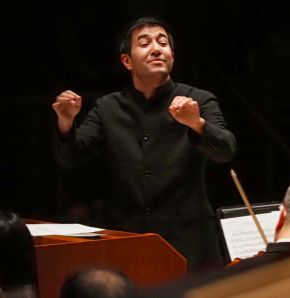|
Symphony
MYSTICAL PLANETS AND LIVELY GERSHWIN ORTIZ AT FINAL SRS CONCERT
by Peter Lert
Sunday, May 4, 2025
Symphony
VSO'S CONCERT MUSIC OF TIME, MUSIC OF PLACE
by Peter Lert
Sunday, April 27, 2025
Choral and Vocal
VOCAL ELEGANCE AND FIRE AT THE 222'S RECITAL APRIL 26
by Pamela Hicks Gailey
Saturday, April 26, 2025
Choral and Vocal
CANTIAMO SONOMA SINGS AN INSPIRED GOOD FRIDAY MOZART REQUIEM CONCERT
by Pamela Hicks Gailey
Friday, April 18, 2025
Symphony
DRAMATIC SHOSTAKOVICH SYMPHONY CLOSES PHILHARMONIC'S 25TH SEASON
by Terry McNeill
Sunday, April 13, 2025
Recital
LARGE COLLEGE OF MARIN AUDIENCE GREETS STOPHER ARTISTRY
by Terry McNeill
Saturday, April 5, 2025
Chamber
FRISSON DELIVERS SHIVERS OF DELIGHT
by Abby Wasserman
Sunday, March 30, 2025
Symphony
OLD AND MOSTLY NEW IN SRS MARCH CONCERT IN WEILL
by Peter Lert
Saturday, March 22, 2025
Symphony
TWO FORMIDABLE SYMPHONIES AND PURPLE MOUNTAINS AT SRS CONCERT
by Peter Lert
Sunday, February 23, 2025
Chamber
THE PARKER CAPTURES DEMANDING ADES QUARTET AT RAC SEBASTOPOL CONCERT
by Peter Lert
Saturday, February 15, 2025
|
 |
 Francesco Lecce-Chong Dec. 9 in Weill Hall |
EVERLASTING LIGHT AT SANTA ROSA SYMPHONY
by Steve Osborn
Monday, December 9, 2019
The Mozart Requiem includes four intermittent vocal soloists, but the real star is the choir, which is featured in almost every movement. That stardom shone bright at the Santa Rosa Symphony’s memorable Requiem performance on Monday night. The soloists were good, but the choir was superb. Located within the orchestra instead of the choir loft, the choristers were fully integrated into the sonic texture, aided in no small part by their excellent diction and well-controlled dynamics.
Instead of the standard Sussmayer version of Mozart’s unfinished masterpiece, conductor Francesco Lecce-Chong chose a contemporary version by musicologist Robert Levin. The differences are mostly subtle, but Levin adds a fully embellished “Amen” fugue at the end of the “Lacrimosa” section and tinkers with the “Sanctus.” The tinkering works, but the new fugue sounds more Baroque than Mozartean.
Those quibbles aside, the performance was nearly transcendent, displaying Mozart’s genius and humanity at its most profound. Conducting without a score, Mr. Lecce-Chong displayed complete command of every measure, eliciting a crisp sound from the orchestra and expressive singing from the choir. The articulation from both players and singers was knife-edged, with every note and syllable distinct. The tempos were brisk and steady.
Standout moments included the “Dies Irae,” which took off like a rocket. The choir’s eyes were glued to the conductor rather than buried in their scores, and they reacted swiftly to his graceful cues. The subsequent “Tuba Mirum” moved at a similarly brisk pace and featured strong solos from bass Philip Skinner and trombonist Amy Bowers. The vocal quartet in the “Recordare” was fine, but the top three singers’ limits became evident over the course of the movement. Soprano Shawnette Sulker had too much vibrato and seemed preoccupied with her score; alto Laura Krumm had good tone but was drowned out; tenor Benjamin Brecher had a sweet sound, but his voice was often constricted. As in the “Tuba Mirum,” Mr. Skinner proved the most consistent.
Mr. Lecce-Chong took a long pause at the end of the new “Amen” section, perhaps to gather his forces for the majestic “Domine Jesu” and “Hostias,” which really cooked. Everyone on stage was swept up by the conductor’s relentless energy, as each gorgeous phrase flowed into the next. The momentum carried into the “Sanctus,” whose “Hosanna in excelsis” lines were downright rollicking. In the “Agnus Dei,” the choir showed off its precise articulation, enunciating “qui tollis peccata mundi” with clarion fervor. The final words of the Requiem—“et lux perpetua luceat eis” (let everlasting light shine upon them)—lived up to their double meaning, referring not only to the light of heaven, but also to Mozart’s eternal genius.
Genius of another kind inhabited the first half of the concert, which opened with a sparkling performance of Haydn’s Symphony No. 39. Mr. Lecce-Chong conducted the reduced ensemble (strings, four horns, two oboes and bassoon) while standing before an elevated fortepiano, on which he interpolated occasional unscored continuo parts. The fortepiano was mostly inaudible, but it did rise to the occasion when the strings played pianissimo.
Haydn’s symphony is a real gem, as deserving of respect as his later efforts. The orchestra opens very quietly, with pregnant, jokey rests between phrases. Despite the quietude, the ensemble bristled with energy that carried over into the later, louder sections. The Andante second movement was spare, elegant and courtly, with bows in perfect sync. A unified, reverberant sound from the strings dominated the Minuet and continued in the dramatic Allegro di molto finale, where the players spun off a series of exemplary runs at a furious pace.
Furious pacing was nowhere in evidence in the next work, “Records from a Vanishing City,” by contemporary composer Jessie Montgomery. In his introduction, Mr. Lecce-Chong said the piece “creates a sense of place” by recreating the “white noise” the composer heard while growing up in the lower east side of Manhattan. The conductor's description turned out to be accurate, but unfortunately the piece never went beyond atmospherics.
Ms. Montgomery is clearly skilled at orchestration, and the density of her sound is remarkable. Nonetheless, her basic modus operandi is to place solos atop a constantly shifting cloud of sound. The results were often beautiful, but the piece never went anywhere, and development was hard to detect.
Reprinted by permission from San Francisco Classical Voice
|

